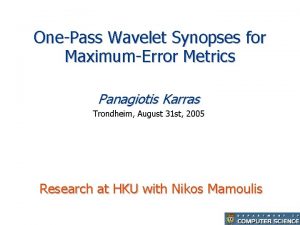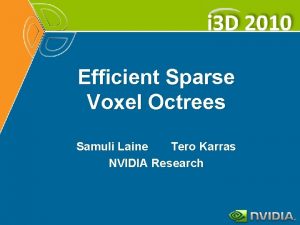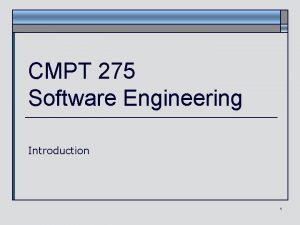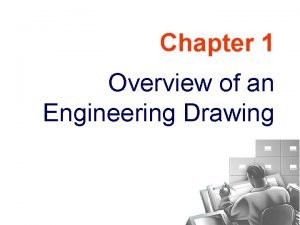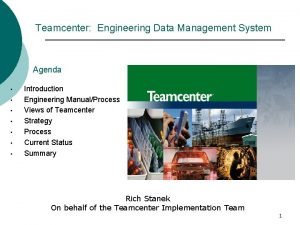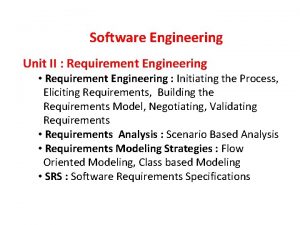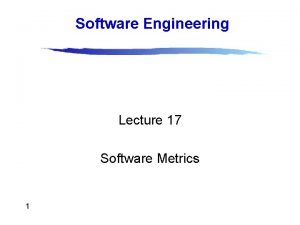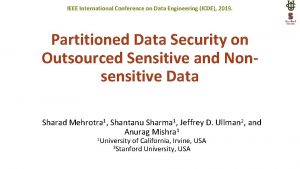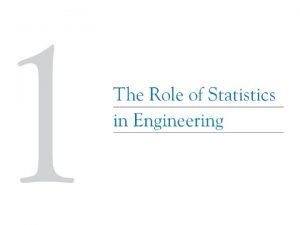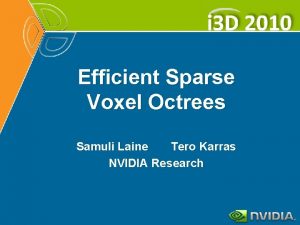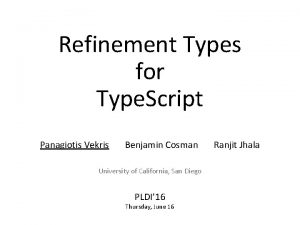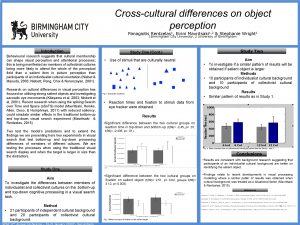Special Topics in Data Engineering Panagiotis Karras CS


![Summarizing Data Streams • Approximate a sequence [d 1, d 2, …, dn] with Summarizing Data Streams • Approximate a sequence [d 1, d 2, …, dn] with](https://slidetodoc.com/presentation_image_h2/fe7a84b7aebb7dcbb4bd3a06429e3c00/image-3.jpg)
![Histograms [KSM 2007] • Solve the error-bounded problem. Maximum Absolute Error bound ε = Histograms [KSM 2007] • Solve the error-bounded problem. Maximum Absolute Error bound ε =](https://slidetodoc.com/presentation_image_h2/fe7a84b7aebb7dcbb4bd3a06429e3c00/image-4.jpg)

![Streamstrapping [Guha 2009] • Metric error satisfies property: • Run multiple algorithms. 1. Read Streamstrapping [Guha 2009] • Metric error satisfies property: • Run multiple algorithms. 1. Read](https://slidetodoc.com/presentation_image_h2/fe7a84b7aebb7dcbb4bd3a06429e3c00/image-6.jpg)
![Streamstrapping [Guha 2009] • Theorem: For any running • Proof: Stream. Strap algorithm achieves Streamstrapping [Guha 2009] • Theorem: For any running • Proof: Stream. Strap algorithm achieves](https://slidetodoc.com/presentation_image_h2/fe7a84b7aebb7dcbb4bd3a06429e3c00/image-7.jpg)
![Streamstrapping [Guha 2009] • Proof (cont’d): Putting it all together, telescoping: added error Total Streamstrapping [Guha 2009] • Proof (cont’d): Putting it all together, telescoping: added error Total](https://slidetodoc.com/presentation_image_h2/fe7a84b7aebb7dcbb4bd3a06429e3c00/image-8.jpg)
![Streamstrapping [Guha 2009] • Theorem: Algorithm runs in space and time. • Proof: Space Streamstrapping [Guha 2009] • Theorem: Algorithm runs in space and time. • Proof: Space](https://slidetodoc.com/presentation_image_h2/fe7a84b7aebb7dcbb4bd3a06429e3c00/image-9.jpg)
![1 D Array Partitioning [KMS 1997] • Problem: Partition an array of n items 1 D Array Partitioning [KMS 1997] • Problem: Partition an array of n items](https://slidetodoc.com/presentation_image_h2/fe7a84b7aebb7dcbb4bd3a06429e3c00/image-10.jpg)
![1 D Array Partitioning [KMS 1997] • Idea: Perform binary search on all possible 1 D Array Partitioning [KMS 1997] • Idea: Perform binary search on all possible](https://slidetodoc.com/presentation_image_h2/fe7a84b7aebb7dcbb4bd3a06429e3c00/image-11.jpg)
![1 D Array Partitioning [KMS 1997] • Solution: Exploit internal structure of O(n 2) 1 D Array Partitioning [KMS 1997] • Solution: Exploit internal structure of O(n 2)](https://slidetodoc.com/presentation_image_h2/fe7a84b7aebb7dcbb4bd3a06429e3c00/image-12.jpg)
![1 D Array Partitioning [KMS 1997] • Calls to F(. . . ) need 1 D Array Partitioning [KMS 1997] • Calls to F(. . . ) need](https://slidetodoc.com/presentation_image_h2/fe7a84b7aebb7dcbb4bd3a06429e3c00/image-13.jpg)
![1 D Array Partitioning [KMS 1997] • The median of medians m is not 1 D Array Partitioning [KMS 1997] • The median of medians m is not](https://slidetodoc.com/presentation_image_h2/fe7a84b7aebb7dcbb4bd3a06429e3c00/image-14.jpg)
![1 D Array Partitioning [KMS 1997] • If median of medians m is not 1 D Array Partitioning [KMS 1997] • If median of medians m is not](https://slidetodoc.com/presentation_image_h2/fe7a84b7aebb7dcbb4bd3a06429e3c00/image-15.jpg)
![1 D Array Partitioning [KMS 1997] 1. 2. 3. 4. 5. Overall Algorithm: Arrange 1 D Array Partitioning [KMS 1997] 1. 2. 3. 4. 5. Overall Algorithm: Arrange](https://slidetodoc.com/presentation_image_h2/fe7a84b7aebb7dcbb4bd3a06429e3c00/image-16.jpg)
![2 D Array Partitioning [KMS 1997] • Problem: Partition a 2 D array of 2 D Array Partitioning [KMS 1997] • Problem: Partition a 2 D array of](https://slidetodoc.com/presentation_image_h2/fe7a84b7aebb7dcbb4bd3a06429e3c00/image-17.jpg)
![2 D Array Partitioning [KMS 1997] • Definition: Two axis-parallel rectangles are independent if 2 D Array Partitioning [KMS 1997] • Definition: Two axis-parallel rectangles are independent if](https://slidetodoc.com/presentation_image_h2/fe7a84b7aebb7dcbb4bd3a06429e3c00/image-18.jpg)
![2 D Array Partitioning [KMS 1997] • At least one line needed to stab 2 D Array Partitioning [KMS 1997] • At least one line needed to stab](https://slidetodoc.com/presentation_image_h2/fe7a84b7aebb7dcbb4bd3a06429e3c00/image-19.jpg)
![2 D Array Partitioning [KMS 1997] The Algorithm: Assume we know optimal W. Step 2 D Array Partitioning [KMS 1997] The Algorithm: Assume we know optimal W. Step](https://slidetodoc.com/presentation_image_h2/fe7a84b7aebb7dcbb4bd3a06429e3c00/image-20.jpg)
![2 D Array Partitioning [KMS 1997] Step 2: (from P to S ) Construct 2 D Array Partitioning [KMS 1997] Step 2: (from P to S ) Construct](https://slidetodoc.com/presentation_image_h2/fe7a84b7aebb7dcbb4bd3a06429e3c00/image-21.jpg)
![2 D Array Partitioning [KMS 1997] Step 3: (from S to M ) Determine 2 D Array Partitioning [KMS 1997] Step 3: (from S to M ) Determine](https://slidetodoc.com/presentation_image_h2/fe7a84b7aebb7dcbb4bd3a06429e3c00/image-22.jpg)
![2 D Array Partitioning [KMS 1997] Step 4: (from M to new partition) For 2 D Array Partitioning [KMS 1997] Step 4: (from M to new partition) For](https://slidetodoc.com/presentation_image_h2/fe7a84b7aebb7dcbb4bd3a06429e3c00/image-23.jpg)
![2 D Array Partitioning [KMS 1997] Step 5: (final) Retain every th horizontal line, 2 D Array Partitioning [KMS 1997] Step 5: (final) Retain every th horizontal line,](https://slidetodoc.com/presentation_image_h2/fe7a84b7aebb7dcbb4bd3a06429e3c00/image-24.jpg)
![2 D Array Partitioning [KMS 1997] Analysis: We have to show that: a. Given 2 D Array Partitioning [KMS 1997] Analysis: We have to show that: a. Given](https://slidetodoc.com/presentation_image_h2/fe7a84b7aebb7dcbb4bd3a06429e3c00/image-25.jpg)
![2 D Array Partitioning [KMS 1997] Lemma 1: (at Step 1) Let block b 2 D Array Partitioning [KMS 1997] Lemma 1: (at Step 1) Let block b](https://slidetodoc.com/presentation_image_h2/fe7a84b7aebb7dcbb4bd3a06429e3c00/image-26.jpg)
![2 D Array Partitioning [KMS 1997] Proof (cont’d): Slab weight exceeding W does not 2 D Array Partitioning [KMS 1997] Proof (cont’d): Slab weight exceeding W does not](https://slidetodoc.com/presentation_image_h2/fe7a84b7aebb7dcbb4bd3a06429e3c00/image-27.jpg)
![2 D Array Partitioning [KMS 1997] Lemma 2: (at Step 4) Weight of any 2 D Array Partitioning [KMS 1997] Lemma 2: (at Step 4) Weight of any](https://slidetodoc.com/presentation_image_h2/fe7a84b7aebb7dcbb4bd3a06429e3c00/image-28.jpg)
![2 D Array Partitioning [KMS 1997] Lemma 3: (at Step 3) If , then 2 D Array Partitioning [KMS 1997] Lemma 3: (at Step 3) If , then](https://slidetodoc.com/presentation_image_h2/fe7a84b7aebb7dcbb4bd3a06429e3c00/image-29.jpg)
![2 D Array Partitioning [KMS 1997] Lemma 4: (at Step 5) If , weight 2 D Array Partitioning [KMS 1997] Lemma 4: (at Step 5) If , weight](https://slidetodoc.com/presentation_image_h2/fe7a84b7aebb7dcbb4bd3a06429e3c00/image-30.jpg)





- Slides: 35

Special Topics in Data Engineering Panagiotis Karras CS 6234 Lecture, March 4 th, 2009

Outline • Summarizing Data Streams. • Efficient Array Partitioning. 1 D Case. 2 D Case. • Hierarchical Synopses with Optimal Error Guarantees.
![Summarizing Data Streams Approximate a sequence d 1 d 2 dn with Summarizing Data Streams • Approximate a sequence [d 1, d 2, …, dn] with](https://slidetodoc.com/presentation_image_h2/fe7a84b7aebb7dcbb4bd3a06429e3c00/image-3.jpg)
Summarizing Data Streams • Approximate a sequence [d 1, d 2, …, dn] with B buckets, si = [bi, ei, vi] so that an error metric is minimized. • Data arrive as a stream: Seen only once. Cannot be stored. • Objective functions: Max. abs. error: Euclidean error:
![Histograms KSM 2007 Solve the errorbounded problem Maximum Absolute Error bound ε Histograms [KSM 2007] • Solve the error-bounded problem. Maximum Absolute Error bound ε =](https://slidetodoc.com/presentation_image_h2/fe7a84b7aebb7dcbb4bd3a06429e3c00/image-4.jpg)
Histograms [KSM 2007] • Solve the error-bounded problem. Maximum Absolute Error bound ε = 2 4 5 6 2 15 17 3 6 9 12 … [ 4 ] [ 16 ] [ 4. 5 ] [… • Generalized to any weighted maximum-error metric. Each value di defines a tolerance interval Bucket closed when running intersection of interval becomes null Complexity:

Histograms • Apply to the space-bounded problem. Perform binary search in the domain of the error bound ε For error values requiring space , with actual error Error-bounded algorithm running under constraint If requires , run an optimality test: instead of space, then optimal solution has been reached. Complexity: Independent of buckets B What about streaming case?
![Streamstrapping Guha 2009 Metric error satisfies property Run multiple algorithms 1 Read Streamstrapping [Guha 2009] • Metric error satisfies property: • Run multiple algorithms. 1. Read](https://slidetodoc.com/presentation_image_h2/fe7a84b7aebb7dcbb4bd3a06429e3c00/image-6.jpg)
Streamstrapping [Guha 2009] • Metric error satisfies property: • Run multiple algorithms. 1. Read first B items, keep reading until first error (>1/M) 2. Start versions for 3. When a version for some fails, a) Terminate all versions for b) Start new versions for using summary of 4. Repeat until end of input. as first input.
![Streamstrapping Guha 2009 Theorem For any running Proof Stream Strap algorithm achieves Streamstrapping [Guha 2009] • Theorem: For any running • Proof: Stream. Strap algorithm achieves](https://slidetodoc.com/presentation_image_h2/fe7a84b7aebb7dcbb4bd3a06429e3c00/image-7.jpg)
Streamstrapping [Guha 2009] • Theorem: For any running • Proof: Stream. Strap algorithm achieves an approximation, copies and initializations. Consider lowest value of for which an algorithm runs. Suppose error estimate was raised j times before reaching Xi : prefix of input just before error estimate was raised for i th time. Yj : suffix between (j-1)th and jth raising of error estimate. Hi : summary built for Xi. Then: target error added error Furthermore: recursion Error estimate is raised by at every time.
![Streamstrapping Guha 2009 Proof contd Putting it all together telescoping added error Total Streamstrapping [Guha 2009] • Proof (cont’d): Putting it all together, telescoping: added error Total](https://slidetodoc.com/presentation_image_h2/fe7a84b7aebb7dcbb4bd3a06429e3c00/image-8.jpg)
Streamstrapping [Guha 2009] • Proof (cont’d): Putting it all together, telescoping: added error Total error is: optimal error Moreover, However, Thus, In conclusion, total error is # Initializations follows. (algorithm failed for it)
![Streamstrapping Guha 2009 Theorem Algorithm runs in space and time Proof Space Streamstrapping [Guha 2009] • Theorem: Algorithm runs in space and time. • Proof: Space](https://slidetodoc.com/presentation_image_h2/fe7a84b7aebb7dcbb4bd3a06429e3c00/image-9.jpg)
Streamstrapping [Guha 2009] • Theorem: Algorithm runs in space and time. • Proof: Space bound follows from copies. Batch input values in groups of Define binary tree of t values, compute min & max over tree nodes: Using tree, max & min of any interval computed in Every copy has to check violation of its bound over t items. Non-violation decided in O(1). Total Violation located in. For all buckets, Over all algorithms it becomes:
![1 D Array Partitioning KMS 1997 Problem Partition an array of n items 1 D Array Partitioning [KMS 1997] • Problem: Partition an array of n items](https://slidetodoc.com/presentation_image_h2/fe7a84b7aebb7dcbb4bd3a06429e3c00/image-10.jpg)
1 D Array Partitioning [KMS 1997] • Problem: Partition an array of n items into p intervals so that the maximum weight of the intervals is minimized. Arises in load balancing in pipelined, parallel environments.
![1 D Array Partitioning KMS 1997 Idea Perform binary search on all possible 1 D Array Partitioning [KMS 1997] • Idea: Perform binary search on all possible](https://slidetodoc.com/presentation_image_h2/fe7a84b7aebb7dcbb4bd3a06429e3c00/image-11.jpg)
1 D Array Partitioning [KMS 1997] • Idea: Perform binary search on all possible O(n 2) intervals responsible for maximum weight result (bottlenecks). • Obstacle: Approximate median has to be calculated in O(n) time.
![1 D Array Partitioning KMS 1997 Solution Exploit internal structure of On 2 1 D Array Partitioning [KMS 1997] • Solution: Exploit internal structure of O(n 2)](https://slidetodoc.com/presentation_image_h2/fe7a84b7aebb7dcbb4bd3a06429e3c00/image-12.jpg)
1 D Array Partitioning [KMS 1997] • Solution: Exploit internal structure of O(n 2) intervals. n columns, column c consisting of Monotonically non-increasing
![1 D Array Partitioning KMS 1997 Calls to F need 1 D Array Partitioning [KMS 1997] • Calls to F(. . . ) need](https://slidetodoc.com/presentation_image_h2/fe7a84b7aebb7dcbb4bd3a06429e3c00/image-13.jpg)
1 D Array Partitioning [KMS 1997] • Calls to F(. . . ) need O(1). (why? ) • Median of any subcolumn determined with one call to F oracle. (how? ) Splitter-finding Algorithm: • Find median weight in each active subcolumn. • Find median of medians m in O(n) (standard). • Cl (Cr): set of columns with median < (>) m.
![1 D Array Partitioning KMS 1997 The median of medians m is not 1 D Array Partitioning [KMS 1997] • The median of medians m is not](https://slidetodoc.com/presentation_image_h2/fe7a84b7aebb7dcbb4bd3a06429e3c00/image-14.jpg)
1 D Array Partitioning [KMS 1997] • The median of medians m is not always a splitter.
![1 D Array Partitioning KMS 1997 If median of medians m is not 1 D Array Partitioning [KMS 1997] • If median of medians m is not](https://slidetodoc.com/presentation_image_h2/fe7a84b7aebb7dcbb4bd3a06429e3c00/image-15.jpg)
1 D Array Partitioning [KMS 1997] • If median of medians m is not a splitter, recur to set of active subcolumns (Cl or Cr) with more elements (ignored elements still considered in future set size calculations). • Otherwise, return m as a good splitter (approximate median). End of Splitter-finding Algorithm.
![1 D Array Partitioning KMS 1997 1 2 3 4 5 Overall Algorithm Arrange 1 D Array Partitioning [KMS 1997] 1. 2. 3. 4. 5. Overall Algorithm: Arrange](https://slidetodoc.com/presentation_image_h2/fe7a84b7aebb7dcbb4bd3a06429e3c00/image-16.jpg)
1 D Array Partitioning [KMS 1997] 1. 2. 3. 4. 5. Overall Algorithm: Arrange intervals in subcolumns. Find a splitter weight m of active subcolumns. Check whether array is partitionable in p intervals of maximum weight m (how? ) If true, then m is upper bound of optimal maximum weight, eliminate half of elements of each subcolumn in Cl - otherwise in Cr. Recur until convergence to optimal m. Complexity: O(n log n)
![2 D Array Partitioning KMS 1997 Problem Partition a 2 D array of 2 D Array Partitioning [KMS 1997] • Problem: Partition a 2 D array of](https://slidetodoc.com/presentation_image_h2/fe7a84b7aebb7dcbb4bd3a06429e3c00/image-17.jpg)
2 D Array Partitioning [KMS 1997] • Problem: Partition a 2 D array of n x n items into a p x p partition (inducing p 2 blocks) so that the maximum weight of the blocks is minimized. Arises in particle-in-cell computations, sparse matric computations, etc. • NP-hard [GM 1996] • APX-hard [CCM 1996]
![2 D Array Partitioning KMS 1997 Definition Two axisparallel rectangles are independent if 2 D Array Partitioning [KMS 1997] • Definition: Two axis-parallel rectangles are independent if](https://slidetodoc.com/presentation_image_h2/fe7a84b7aebb7dcbb4bd3a06429e3c00/image-18.jpg)
2 D Array Partitioning [KMS 1997] • Definition: Two axis-parallel rectangles are independent if their projections are disjoint along both the x-axis and the y-axis. • Observation 1: If an array has a partition, then it may contain at most independent rectangles of weight strictly greater than W. (why? )
![2 D Array Partitioning KMS 1997 At least one line needed to stab 2 D Array Partitioning [KMS 1997] • At least one line needed to stab](https://slidetodoc.com/presentation_image_h2/fe7a84b7aebb7dcbb4bd3a06429e3c00/image-19.jpg)
2 D Array Partitioning [KMS 1997] • At least one line needed to stab each of the independent rectangles. • Best case: independent rectangles
![2 D Array Partitioning KMS 1997 The Algorithm Assume we know optimal W Step 2 D Array Partitioning [KMS 1997] The Algorithm: Assume we know optimal W. Step](https://slidetodoc.com/presentation_image_h2/fe7a84b7aebb7dcbb4bd3a06429e3c00/image-20.jpg)
2 D Array Partitioning [KMS 1997] The Algorithm: Assume we know optimal W. Step 1: (define P ) Given W, obtain partition such that each row/column within any block has weight at most 2 W. (how? ) Independent horizontal/vertical scans, keeping track of running sum of weights of each row/column in block. (why exists ? )
![2 D Array Partitioning KMS 1997 Step 2 from P to S Construct 2 D Array Partitioning [KMS 1997] Step 2: (from P to S ) Construct](https://slidetodoc.com/presentation_image_h2/fe7a84b7aebb7dcbb4bd3a06429e3c00/image-21.jpg)
2 D Array Partitioning [KMS 1997] Step 2: (from P to S ) Construct set of all minimal rectangles of weight more than W, entirely contained in blocks of. (how? ) Start from each location within block, consider all possible rectangles in order of increasing sides, until W exceeded, keep minimal ones. Property of S : block weight at most 3 W. (why? ) Hint : rows/columns in blocks of P at most 2 W.
![2 D Array Partitioning KMS 1997 Step 3 from S to M Determine 2 D Array Partitioning [KMS 1997] Step 3: (from S to M ) Determine](https://slidetodoc.com/presentation_image_h2/fe7a84b7aebb7dcbb4bd3a06429e3c00/image-22.jpg)
2 D Array Partitioning [KMS 1997] Step 3: (from S to M ) Determine local 3 -optimal set independent rectangles. of 3 -optimality : There does not exist set of independent rectangles in that, added to after removing rectangles from it, do not violate independence condition. Polynomial-time construction (how? with swaps: local optimality easy)
![2 D Array Partitioning KMS 1997 Step 4 from M to new partition For 2 D Array Partitioning [KMS 1997] Step 4: (from M to new partition) For](https://slidetodoc.com/presentation_image_h2/fe7a84b7aebb7dcbb4bd3a06429e3c00/image-23.jpg)
2 D Array Partitioning [KMS 1997] Step 4: (from M to new partition) For each rectangle in M, set two straddling horizontal and two straddling vertical lines that induce it. At most partition derived New partition: P from step 1 together with this. horizontal lines vertical lines
![2 D Array Partitioning KMS 1997 Step 5 final Retain every th horizontal line 2 D Array Partitioning [KMS 1997] Step 5: (final) Retain every th horizontal line,](https://slidetodoc.com/presentation_image_h2/fe7a84b7aebb7dcbb4bd3a06429e3c00/image-24.jpg)
2 D Array Partitioning [KMS 1997] Step 5: (final) Retain every th horizontal line, every th vertical line. Maximum weight increased at most by
![2 D Array Partitioning KMS 1997 Analysis We have to show that a Given 2 D Array Partitioning [KMS 1997] Analysis: We have to show that: a. Given](https://slidetodoc.com/presentation_image_h2/fe7a84b7aebb7dcbb4bd3a06429e3c00/image-25.jpg)
2 D Array Partitioning [KMS 1997] Analysis: We have to show that: a. Given W (large enough) such that there exists partition, the maximum block weight in constructed partition is b. Minimum W for which analysis holds (found by binary search) is upper bound to optimum W.
![2 D Array Partitioning KMS 1997 Lemma 1 at Step 1 Let block b 2 D Array Partitioning [KMS 1997] Lemma 1: (at Step 1) Let block b](https://slidetodoc.com/presentation_image_h2/fe7a84b7aebb7dcbb4bd3a06429e3c00/image-26.jpg)
2 D Array Partitioning [KMS 1997] Lemma 1: (at Step 1) Let block b contained in partition P. If b exceeds 27 W, then b can be partitioned in 3 independent rectangles of weight >W. Proof: Vertical scan in b, cut as soon as seen slab weight exceeds 7 W. (hence slab weight < 9 W ) (why? ) Horizontal scan, cut as soon as one seen slab weight exceeds W.
![2 D Array Partitioning KMS 1997 Proof contd Slab weight exceeding W does not 2 D Array Partitioning [KMS 1997] Proof (cont’d): Slab weight exceeding W does not](https://slidetodoc.com/presentation_image_h2/fe7a84b7aebb7dcbb4bd3a06429e3c00/image-27.jpg)
2 D Array Partitioning [KMS 1997] Proof (cont’d): Slab weight exceeding W does not exceed 3 W. (why? ) Eventually, 3 rectangles weighting >W each.
![2 D Array Partitioning KMS 1997 Lemma 2 at Step 4 Weight of any 2 D Array Partitioning [KMS 1997] Lemma 2: (at Step 4) Weight of any](https://slidetodoc.com/presentation_image_h2/fe7a84b7aebb7dcbb4bd3a06429e3c00/image-28.jpg)
2 D Array Partitioning [KMS 1997] Lemma 2: (at Step 4) Weight of any block of Step-4 -partition is Proof: Case 1: Weight of b is O(W). (recall block in S <3 W ) Case 2: Weight of b is <27 W. If >27 W, then b partitionable in 3 independent rectangles, which can substitute the at most 2 blocks in M non-independent of b: violates 3 -optimality of M.
![2 D Array Partitioning KMS 1997 Lemma 3 at Step 3 If then 2 D Array Partitioning [KMS 1997] Lemma 3: (at Step 3) If , then](https://slidetodoc.com/presentation_image_h2/fe7a84b7aebb7dcbb4bd3a06429e3c00/image-29.jpg)
2 D Array Partitioning [KMS 1997] Lemma 3: (at Step 3) If , then Proof: Weight of rectangles in M is >W. By Observation 1, at most independent rectangles can be contained in M.
![2 D Array Partitioning KMS 1997 Lemma 4 at Step 5 If weight 2 D Array Partitioning [KMS 1997] Lemma 4: (at Step 5) If , weight](https://slidetodoc.com/presentation_image_h2/fe7a84b7aebb7dcbb4bd3a06429e3c00/image-30.jpg)
2 D Array Partitioning [KMS 1997] Lemma 4: (at Step 5) If , weight of any block in final solution is Proof: At Step 5, maximum weight increased at most by By Lemma 2, maximum weight is Hence, final weight is (a) Least W for which Step 1 and Step 3 succeed exceeds optimum W. Found by binary search. (b)

Compact Hierarchical Histograms • Assign arbitrary values to CHH coefficients, so that a maximumerror metric is minimized. c 0 • Heuristic solutions: Reiss et al. VLDB 2006 c 1 time space c 2 c 3 c 4 d 0 d 1 c 5 d 2 c 6 d 3 The benefit of making node B a bucket (occupied) node depends on whether node A is a bucket node – and also on whether node C is a bucket node. [Reiss et al. VLDB 2006]

Compact Hierarchical Histograms • Solve the error-bounded problem. Next-to-bottom level case c 2 i ci c 2 i+1 c 2 i ci

Compact Hierarchical Histograms • Solve the error-bounded problem. General, recursive case time Complexity: (space-efficient) space • Apply to the space-bounded problem. Complexity: Polynomially Tractable

References 1. P. Karras, D. Sacharidis, N. Mamoulis: Exploiting duality in summarization with deterministic guarantees. KDD 2007. 2. S. Guha: Tight results for clustering and summarizing data streams. ICDT 2009. 3. S. Khanna, S. Muthukrishnan, S. Skiena: Efficient Array Partitioning. ICALP 1997. 4. F. Reiss, M. Garofalakis, and J. M. Hellerstein: Compact histograms for hierarchical identifiers. VLDB 2006. 5. P. Karras, N. Mamoulis: Hierarchical synopses with optimal error guarantees. ACM TODS 33(3): 2008.

Thank you! Questions?
 Panagiotis karras
Panagiotis karras Tero karras
Tero karras Software engineering course syllabus
Software engineering course syllabus Panagiotis farantatos
Panagiotis farantatos Panagiotis pantzos
Panagiotis pantzos Panagiotis spentzouris
Panagiotis spentzouris Panagiotis papadimitriou
Panagiotis papadimitriou 3232 special investigative topics
3232 special investigative topics Special investigative topics 3232
Special investigative topics 3232 Uiuc cs 527
Uiuc cs 527 Software engineering important topics
Software engineering important topics Engineering drawing chapter 1
Engineering drawing chapter 1 Engineering management topics
Engineering management topics Engineering meeting topics
Engineering meeting topics Ku leuven financial engineering
Ku leuven financial engineering Data warehouse research topics
Data warehouse research topics Bin yao
Bin yao Computer based system engineering in software engineering
Computer based system engineering in software engineering Forward engineering and reverse engineering
Forward engineering and reverse engineering Dicapine
Dicapine Elegant systems
Elegant systems Reverse engineering vs forward engineering
Reverse engineering vs forward engineering Special education data collection
Special education data collection Engineering data management system
Engineering data management system Cspec in software engineering
Cspec in software engineering Data structure metrics
Data structure metrics Big data in electrical engineering
Big data in electrical engineering Data flow model in software engineering
Data flow model in software engineering Data dictionary software engineering
Data dictionary software engineering Ieee international conference on data engineering
Ieee international conference on data engineering Terminator dfd
Terminator dfd Samples of collecting engineering data
Samples of collecting engineering data School magazine examples
School magazine examples Persuasive writing structure year 9
Persuasive writing structure year 9 How to write a good thematic essay
How to write a good thematic essay Behavioural training topics
Behavioural training topics
